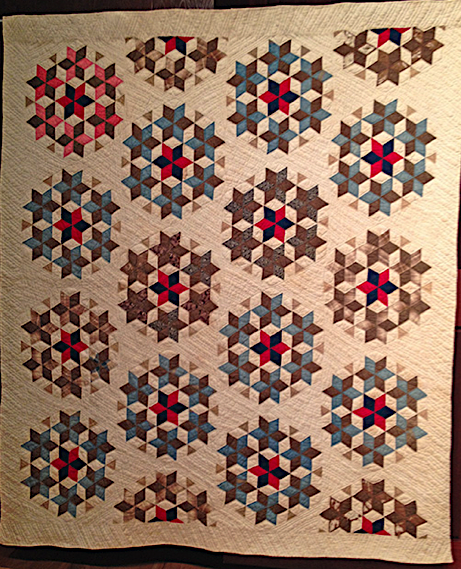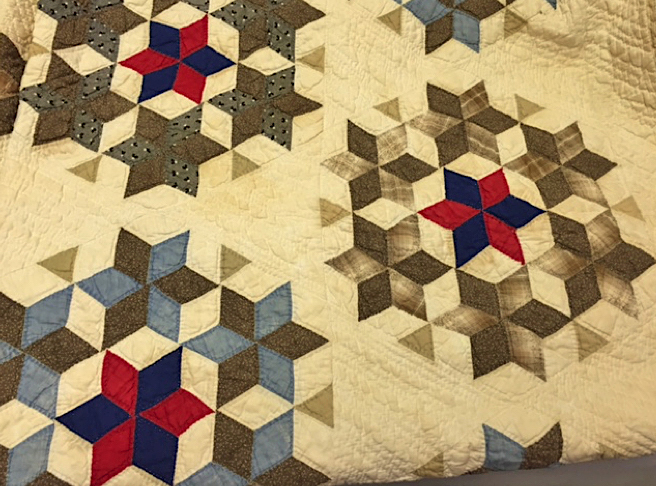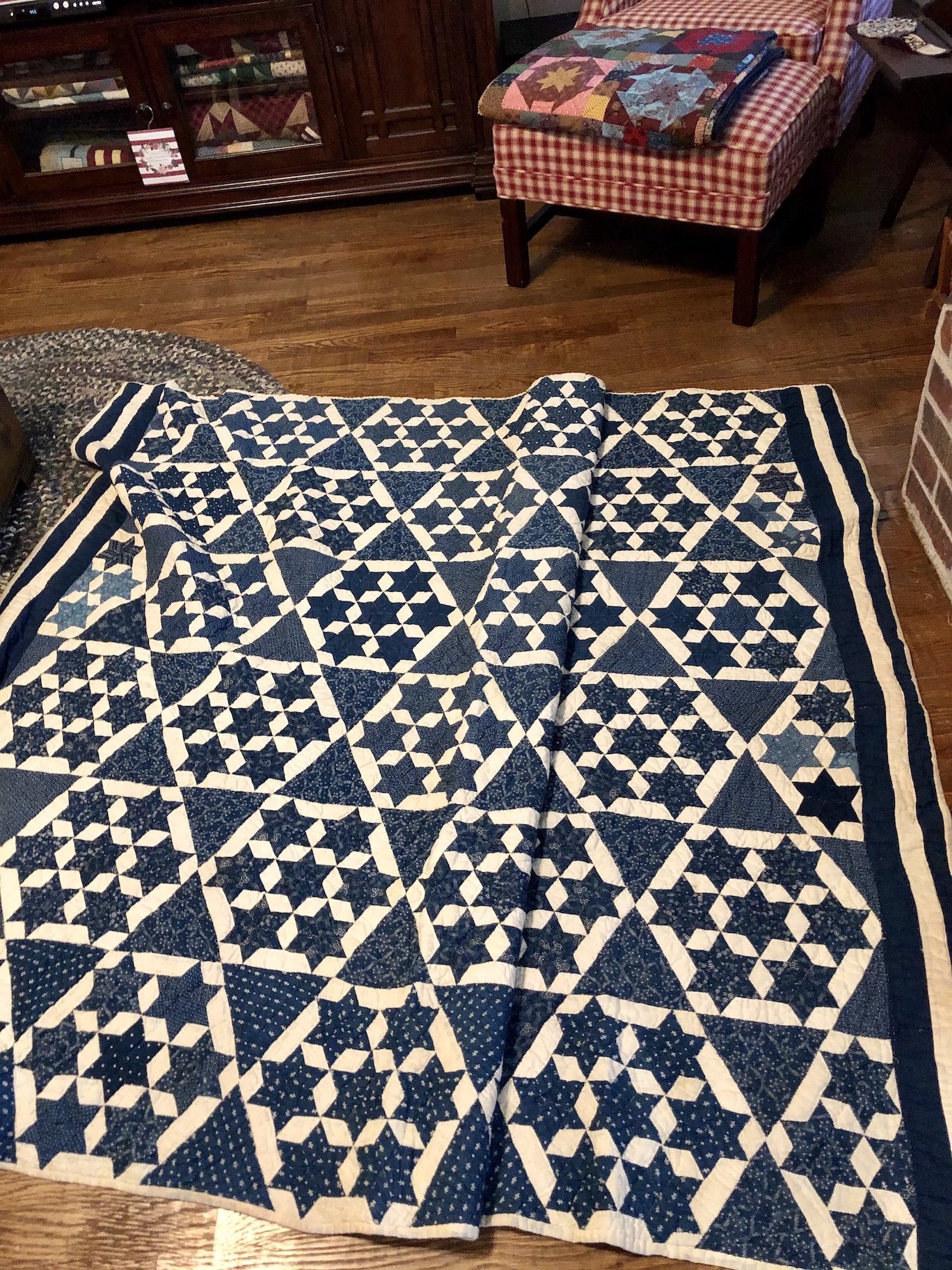
Seven Sisters Quilt made by Mattye Mae Taylor, 1890s. Gift of Mr. and Mrs. Bobby Joe Moody (Charlotte Lamb).
TTU-H2016-020-002. Photo courtesy of the Museum of Texas Tech University.
Seven Sisters Quilts: Shooting Stars or a Shootout?
By Marian Ann J. Montgomery, Ph.D. Curator of Clothing and Textiles,
The Museum of Texas Tech University
Stars are a prime symbol at this time of the year for those celebrating Christmas. The star that led the Wise Men to find the Christ Child in Bethlehem features prominently on Christmas cards, wrapping paper and Christmas decorations. It seems timely to enjoy the Seven Sisters quilt block pattern—with a star representing each sister.
The pattern is named for “The seven lovely daughters of the Fowler family” of Old Virginia” explained Nancy Cabot in her Chicago Tribune column in 1933. Of course, other names for the pattern exist such as Seven Stars and Virginia Pride. It is possible that the seven stars also stood for the seven states of the Confederacy. A quick search on the Internet reveals many different colorways for making the block. The popularity of this quilt pattern has remained constant from the 19th century to present day.
Two lovely, late 19th century, versions are part of the collection of the Museum of Texas Tech University. The first quilt came to the Museum with the family information listing Mattye Mae Taylor (b. March 6, 1892, d. Jan. 29, 1968) as the maker. Her parents came to Texas and had settled near Dallas by the time she was born. In 1960, an unmarried Mattye Mae and her parents moved to Graham, Texas. It is quite possible that they did so at the same time. Why the family chose to move to Graham is not known, but Velma, Mattye Mae’s older sister lived in the nearby town of Olney.
At the time of Mattye Mae’s death the family quilts were passed on to the Velma. After Velma’s death, her husband, Charlie Pardue, married Pauline Marjorie Bloodworth Lamb Jordan. Pauline’s family inherited the quilts and subsequently gave them to the museum with the attribution listing Mattye Mae Taylor as the maker.

Seven Sisters quilt c 1890 made either by Christianna Elizabeth "Annie" Bradley Taylor or her daughter Mattye Mae Taylor. Gift of Mr. and Mrs. Bobby Joe Moody (Charlotte Lamb), TTU-H2016-020-002
When the quilt came to the Museum, the life dates of Mattye Mae was unknown, and a circa date of 1890 was assigned. Given that the quilt was made with solid fabrics, it was more difficult to be certain of the date it was constructed. After subsequent research it was determined that Mattye May Taylor was not born until 1892. The original date of 1890 listing Mattie May Taylor as the maker of the quilt was either wrong, or, was the work of her mother Christianna Elizabeth “Annie” Bradley Taylor (b. Aug 19, 1870, m 1881, d. Feb. 12, 1946, Mrs. Samuel Pinkney). Given the condition and the fine quilting on the quilt it is likely that “Annie” Taylor made the quilt. Being the oldest daughter, Mattye Mae would have been in line to receive the quilts upon her Mother’s death.
As a single woman, it is possible that Mattye Mae lived with her parents, who also resided in town. Over the years the quilts were passed (after Mattye Mae’s death) from Velma (the oldest surviving sister), to the family of Velma’s husband’s second wife. It is quite possible that with this passing of quilts from one family to another, that information regarding the original maker was confused. This type of mistake across generations is not an uncommon occurrence. Once again this brings up the need for and importance of labeling quilts.

Seven Sisters quilt made by Maggie May Payne Puddy, circa 1897
The second quilt with the Seven Sisters pattern is made of printed, dark blue, indigo printed fabrics, and came with an attribution of having been made by Maggie May Payne Puddy (b. Nov. 18, 1880, m 1897, d. Feb. 22, 1973, Mrs. Albert). Blue and white printed indigo was popular at the end of the 19th century and so this quilt was possibly made before the birth of their first child in 1898. Maggie Mae had an interesting childhood.

Maggie May and Albert Puddy taken circa 1912. Photo courtesy of the Museum of Texas Tech University.
Maggie May was born in 1880, to John and Sarah “Sally” Antiemicie Lindsey Payne, in Hico, Texas. At some point after her birth, John became a cowboy with The Hashknife Outfit. In the mid 1880s, due to overgrazing, the herd moved west in search of greener pastures, finally settling in Arizona. The Hashknife Outfit became part of the Aztec corporation. Several of Aztec’s early employees were Texas cowboys whose abilities made them legends among their fellow ranchers during their years in Arizona. Among the group bringing some 33,000 head of cattle and 2, 000 horses from Texas, was also a number of notoriously rowdy and violent original Hashknife cowboys in the group traveling from Texas to Arizona.
Gunfights soon escalated between the local residents and the cowboys. In 1886 there were 26 shooting deaths among a population of approximately 250. It may have been due to the escalating violence in Arizona that led Sally to return, along with her three children, to Texas where she had family. It is not known whether John Payne was one of the violent cowboys. He was killed sometime in the middle of 1887, during the decade-long feud over rangeland and resources (known as the Arizona Pleasant Valley War), between cattlemen and sheep herders.
Seldom are quilts associated with shootouts. Who would have thought that looking at star quilts associated with the Seven Sisters pattern that one would learn the history of a shootout? What other stories could our quilts tell?




.jpg)



RSS feed for comments to this post